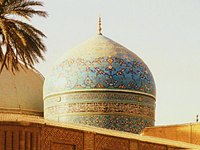Moinuddin Hadi Naqshband
An editor has nominated this article for deletion. You are welcome to participate in the deletion discussion, which will decide whether or not to retain it. |
Moinuddin Hadi Naqshband | |
|---|---|
 Ziyarat Naqshband Sahab | |
| Personal life | |
| Born | |
| Died | 5 May 1674 |
| Resting place | Ziyarat Naqshband Sahab |
| Parent(s) | Khawand Mahmud, known by his folllowers as Hazrat Ishaan |
| Notable work(s) | Fatawa Naqshbandiyya[1] |
| Religious life | |
| Religion | Islam |
| Muslim leader | |
| Predecessor | Hazrat Ishaan |
| Successor | Sayyid Mirza Nizamuddin Sayyid Mir Jan (Uwaisiyya influence) |
| Part of a series on Islam Sufism |
|---|
 |
|
|
Moinuddin Hadi Naqshband, also known as Khwaja Muin al-Din al-Naqshbandi al-Kashmiri (died 5 May 1674), was a 17th-century Sufi saint from Bukhara and a direct descendant of Baha al-Din Naqshband. He succeeded his father, Hazrat Ishaan in the Naqshbandi Ishaani Silsila within the Naqshbandi Sufi order.
Life
Moinuddin Hadi Naqshband migrated with his family from Bukhara to the Gujarat Sultanate via Kashgar through Silk Road, in the reign of Akbar. They eventually moved to Kashmir Valley in 1601.[2][3]
Ancestry
Moinuddin Hadi Naqshband was a Sayyid, a direct descendant of the Islamic prophet Muhammad through his daughter Fatima al-Zahra and his son-in-law and cousin Ali ibn Abu Talib, through Moinuddin Hadi Naqshband's father Hazrat Ishaan who was a seventh generation descendant of Baha al-Din Naqshband.[4]
Successors
Khwaja Moinuddin Hadi Naqshband was succeeded by his grandson Sayyid Mirza Nizamuddin Naqshbandi, because his three sons Khwaja Jani, Khwaja Zia and Khwaja Sharifuddin Muhammad died before he himself passed away. The Silsila of Khwaja Moinuddin Naqshband later came to an end after the martyrdom of his descendant Khwaja Kamaluddin Naqshbandi, but was restarted by his descendant Sayyid Mir Jan in the mid 19th century.[5]
References
- ^ Sohail, Dr Muhammad; Bibi, Dr Nosheen; Khan, Dr Mumtaz (2022-07-31). "A Critical & Comparative Study of the Manuscript Fatawa Naqshbandi of Imam Muin-ud-Din Al- Naqshbandi Al-Kashmiri:". Tahdhib-al-Afkar. 9 (1): 161–172. ISSN 2411-6211.
- ^ https://egyankosh.ac.in/bitstream/123456789/84178/3/Unit-9.pdf
- ^ https://core.ac.uk/download/pdf/144524519.pdf
- ^ "Tarikh-i Hassan | WorldCat.org". search.worldcat.org. Retrieved 2025-01-25.
- ^ Nicholson, Reynold (2000). E. J. W. Gibb Memorial.